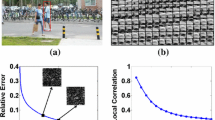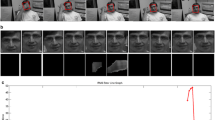Abstract
In visual tracking, designing an effective and robust target appearances remains a challenging work due to variations of complicated target appearances and other challenging factors, such as drastic illumination variations, object rotations, partial occlusions, nonrigid deformation, and fast motion. Existing tracking algorithms use previous tracking results as target templates to represent a target candidate. Such target representations are not robust to drastic appearance variations. In this paper, we represent a target candidate as a linear combination of a set of matrix basis. These bases are obtained from a probabilistic matrix factorization, which are learned from previous tracking result examples. The learned matrix basis can capture target structure information and local information. The matrix factorization based on previous tracking result examples over frames can learn target appearance variations in the tracking process. Such target representation is robust to shape variations and outliers. With this kind of target appearances, we propose a novel tracking algorithm in a particle filter framework. Extensive experiments conducted on some challenging video sequences demonstrate the proposed tracking algorithm is effective and robust to outliers and other complicated appearance variations.



Similar content being viewed by others
REFERENCES
B. Babenko, M. Yang, and S. Belongie, “Robust object tracking with online multiple instance learning,” IEEE Trans. Pattern Anal. Mach. Intell. 33, 1619–1632 (2011). https://doi.org/10.1109/TPAMI.2010.226
Q. Bai, Z. Wu, S. Sclaroff, M. Betke, and C. Monnier, “Randomized ensemble tracking,” in IEEE Int. Conf. on Computer Vision, Sydney, 2013 (IEEE, 2013), pp. 2040–2047. https://doi.org/10.1109/ICCV.2013.255
L. Bertinetto, J. Valmadre, J. F Henriques, A. Vedaldi, and P. Torr, “Fully-convolutional siamese networks for object tracking,” in Computer Vision–ECCV 2016 Workshops, Ed. by G. Hua and H. Jégou, Lecture Notes in Computer Science, vol. 9914 (Springer, Cham, 2016), pp. 850–865. https://doi.org/10.1007/978-3-319-48881-3_56
L. Bertinetto, J. Valmadre, S. Golodetz, O. Miksik, and P. Torr, “Staple: Complementary learners for real-time tracking,” in IEEE Conf. on Computer Vision and Pattern Recognition, Las Vegas, 2016 (IEEE, 2016), pp. 1401–1409. https://doi.org/10.1109/CVPR.2016.156
Z. Chi, H. Li, H. Hu, and M. Yang, “Dual deep network for visual tracking,” IEEE Trans. Image Process. 26, 2005–2015 (2017). https://doi.org/10.1109/TIP.2017.2669880
J. Choi, H. Chang, S. Yun, T. Fischer, and Y. Jin, “Attentional correlation filter network for adaptive visual tracking,” in IEEE Conf. on Computer Vision and Pattern Recognition, Honolulu, Hawaii, 2017 (IEEE, 2017), pp. 4828–4837. https://doi.org/10.1109/CVPR.2017.513
J. Gao, H. Ling, W. Hu, and J. Xing, “Transfer learning based visual tracking with Gaussian processes regression,” in Computer Vision–ECCV 2014, Ed. by D. Fleet, T. Pajdla, B. Schiele, and T. Tuytelaars (Springer, Cham, 2014), pp. 188–203. https://doi.org/10.1007/978-3-319-10578-9_13
J. Gao, T. Zhang, and C. Xu, “Graph convolutional tracking,” in IEEE Conf. on Computer Vision and Pattern Recognition, 2019, (IEEE, 2019), pp. 4649–4659. https://doi.org/10.1109/CVPR.2019.00478
Q. Guo, W. Feng, C. Zhou, R. Huang, L. Wan, and S. Wang, “Learning dynamic siamese network for visual object tracking,” in IEEE Int. Conf. on Computer Vision, Venice, 2017 (IEEE, 2017), pp. 1781–1789. https://doi.org/10.1109/ICCV.2017.196
S. Hare, A. Saffari, and P. H. S. Torr, “Struck: Structured output tracking with kernels,” in Int. Conf. on Computer Vision, Barcelona, 2011 (IEEE, 2011), pp. 263–270. https://doi.org/10.1109/ICCV.2011.6126251
S. He, Q. Yang, R. Lau, J. Wang, and M. Yang, “Visual tracking via locality sensitive histograms,” in IEEE Conf. on Computer Vision and Pattern Recognition, Portland, Ore., 2013 (IEEE, 2013), pp. 2427–2434. https://doi.org/10.1109/CVPR.2013.314
J. Henriques, R. Caseiro, P. Martins, and J. Batista, “High-speed tracking with kernelized correlation filters,” IEEE Trans. Pattern Anal. Mach. Intell. 37, 583–596 (2014). https://doi.org/10.1109/TPAMI.2014.2345390
Z. Huang, C. Fu, Y. Li, F. Lin, and P. Lu, “Learning aberrance repressed correlation filter for real-time UAV tracking,” in IEEE/CVF Int. Conf. on Computer Vision (ICCV), Seoul, 2019 (IEEE, 2019), pp. 2891–2900. https://doi.org/10.1109/ICCV.2019.00298
M. Isard, and A. Blake, “CONDENSATION—conditional density propagation for visual tracking,” Int. J. Comput. Vision 29, 5–28 (1998). https://doi.org/10.1023/A:1008078328650
X. Jia, H. Lu, and M. Yang, “Visual tracking via adaptive structural local sparse appearance model,” in IEEE Conf. on Computer Vision and Pattern Recognition, Providence, R.I., 2012 (IEEE, 2012), pp. 1822–1829. https://doi.org/10.1109/CVPR.2012.6247880
A. Krizhevsky, I. Sutskever, and G. E Hinton, “ImageNet classification with deep convolutional neural networks,” in Proc. of the 25th Int. Conf. on Neural Information Processing Systems, Lake Tahoe, Nev., 2012 (Curran Associates, Red Hook, N.Y., 2012), vol. 1, pp. 1097–1105.
X. Li, Y. Zha, T. Zhang, Z. Cui, W. Zuo, Z. Hou, H. Lu, and H. Wang, “Survey of visual object tracking algorithms based deep learning,” J. Image Graphics 24, 2057–2080 (2019).
S. Liu, T. Zhang, X. Cao, and C. Xu, “Structural correlation filter for robust visual tracking,” in IEEE Conf. on Computer Vision and Pattern Recognition (CVPR), Las Vegas, 2016 (IEEE, 2016), pp. 4312–4320. https://doi.org/10.1109/CVPR.2016.467
C. Ma, J.-B. Huang, X. Yang, and M.-H. Yang, “Hierarchical convolutional features for visual tracking,” in IEEE Int. Conf. on Computer Vision, Santiago, 2015 (IEEE, 2015), pp. 3074–3082. https://doi.org/10.1109/ICCV.2015.352
X. Mei and H. Ling, “Robust visual tracking and vehicle classification via sparse representation,” IEEE Trans. Pattern Anal. Mach. Intell. 33, 2259–2272 (2011). https://doi.org/10.1109/TPAMI.2011.66
H. Nam and B. Han, “Learning multi-domain convolutional neural networks for visual tracking,” in IEEE Conf. on Computer Vision and Pattern Recognition (CVPR), Las Vegas, 2016 (IEEE, 2016), pp. 4293–4302. https://doi.org/10.1109/CVPR.2016.465
X. Ren and D. Ramanan, “Histograms of sparse codes for object detection,” in IEEE Conf. on Computer Vision and Pattern Recognition, Portland, Ore., 2013 (IEEE, 2013), pp. 3246–3253. https://doi.org/10.1109/CVPR.2013.417
D. Wang, H. Lu, and M. Yang, “Least soft-threshold squares tracking,” in IEEE Int. Conf. on Computer Vision and Pattern Recognition, Portland, Ore., 2013 (IEEE, 2013), pp. 2371–2378. https://doi.org/10.1109/CVPR.2013.307
N. Wang, T. Yao, J. Wang, and D.-Y. Yeung, “A probabilistic approach to robust matrix factorization,” in Computer Vision–ECCV 2012, Ed. by A. Fitzgibbon, S. Lazebnik, P. Perona, Y. Sato, and C. Schmid, Lecture Notes in Computer Science, vol. 7578 (Springer, Berlin, 2012), pp. 126–139. https://doi.org/10.1007/978-3-642-33786-4_10
N. Wang, W. Zhou, Q. Tian, R. Hong, M. Wang, and H. Li, “MultiCue correlation filters for robust visual tracking,” in IEEE Conf. on Computer Vision and Pattern Recognition, Salt Lake City, Utah, 2018 (IEEE, 2018), pp. 4844–4853. https://doi.org/10.1109/CVPR.2018.00509
Y. Wu, J. Lim, and M. Yang, “Object tracking benchmark,” IEEE Trans. Pattern Anal. Mach. Intell. 37, 1834–1848 (2015). https://doi.org/10.1109/TPAMI.2014.2388226
Y. Xie, W. Zhang, C. Li, S. Lin, Y. Qu, and Y. Zhang, “Discriminative object tracking via sparse representation and online dictionary learning,” IEEE Trans. Cybern. 44, 539–553 (2014). https://doi.org/10.1109/TCYB.2013.2259230
A. Yilmaz, O. Javed, and M. Shah, “Object tracking: A survey,” ACM Comput. Surv. 38 (4), 1–45 (2006). https://doi.org/10.1145/1177352.1177355
T. Zhang, S. Liu, N. Ahuja, M. Yang, and B. Ghanem, “Robust visual tracking via consistent low-rank sparse learning,” Int. J. Comput. Vision 111, 171–190 (2015). https://doi.org/10.1007/s11263-014-0738-0
T. Zhang, C. Xu, and M.-H. Yang, “Robust structure sparse tracking,” IEEE Trans. Pattern Anal. Mach. Intell. 41, 473–486 (2019). https://doi.org/10.1109/TPAMI.2018.2797082
T. Zhang, C. Xu, and M.-H. Yang, “Multi-task correlation particle filter for robust object tracking, in IEEE Conf. on Computer Vision and Pattern Recognition (CVPR), Honolulu, Hawaii, 2017 (IEEE, 2017), pp. 4819–4827. https://doi.org/10.1109/CVPR.2017.512
H. Zhao, G. Yang, D.Wang, and H. Lu, “Lightweight deep neural network for real-time visual tracking with mutual learning,” in IEEE Int. Conf. on Image Processing, Taipei, 2019 (IEEE, 2019), pp. 3063–3067. https://doi.org/10.1109/ICIP.2019.8803340
W. Zhong, H. Lu, and M. Yang, “Robust object tracking via sparsity-based collaborative model,” in IEEE Conf. on Computer Vision and Pattern Recognition, Providence, R.I., 2012 (IEEE, 2012), pp. 1838–1845. https://doi.org/10.1109/CVPR.2012.6247882
Author information
Authors and Affiliations
Corresponding authors
Ethics declarations
COMPLIANCE WITH ETHICAL STANDARDS
This article is a completely original work of its authors; it has not been published before and will not be sent to other publications until the PRIA Editorial Board decides not to accept it for publication.
Conflict of Interest
The authors declare that they have no conflicts of interest.
Additional information

Xinyi Wei, is an undergraduate in Nanchang University and is now in her junior year. Her research interests include image processing, machine learning, and artificial intelligence.

Zhenrong Lin, is an Associate Professor and postgraduate tutor in the Computer Science and Technology Department of Information and Engineering School in Nanchang University. His research interests include image processing, visual tracking, and information security.

Tao Liu, is a MS candidate. His research interest includes artificial intelligence.

Le Zhang, is a lecturer in the Department of Computer Science and Technology, Nanchang University. His research interest includes visual tracking and data mining.
Rights and permissions
About this article
Cite this article
Xinyi Wei, Lin, Z., Liu, T. et al. Probabilistic Matrix Factorization for Visual Tracking. Pattern Recognit. Image Anal. 32, 57–66 (2022). https://doi.org/10.1134/S1054661822010114
Received:
Revised:
Accepted:
Published:
Issue Date:
DOI: https://doi.org/10.1134/S1054661822010114




